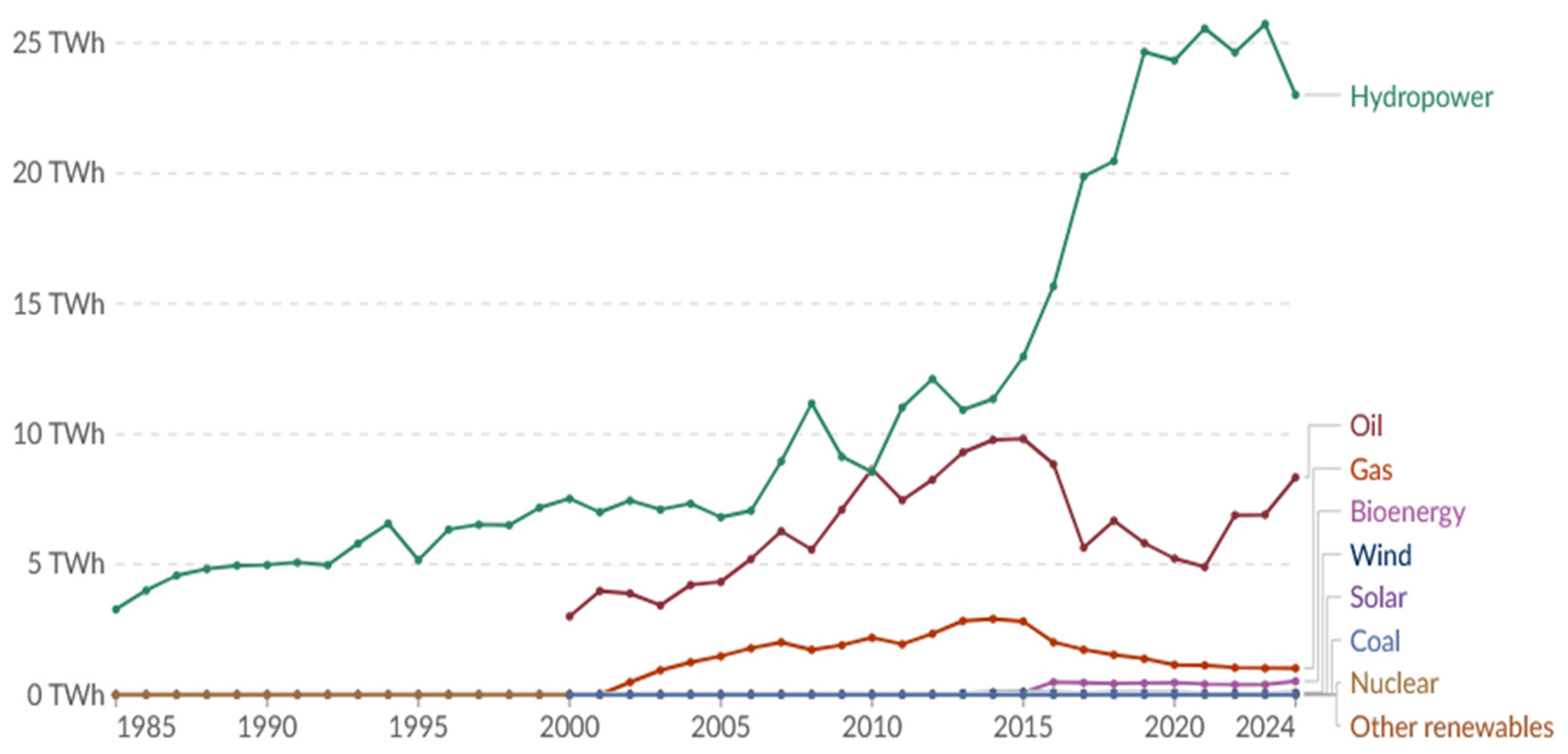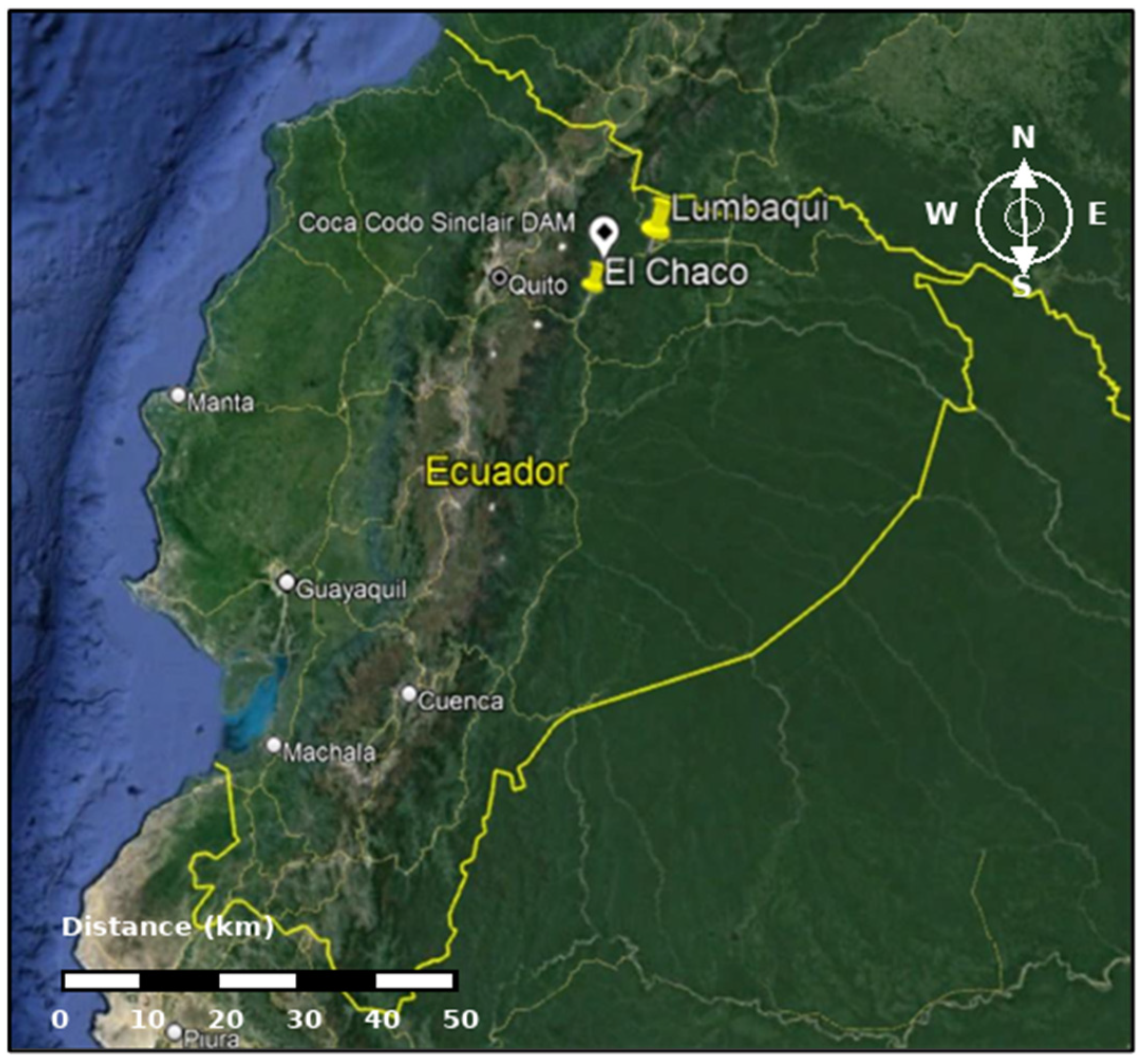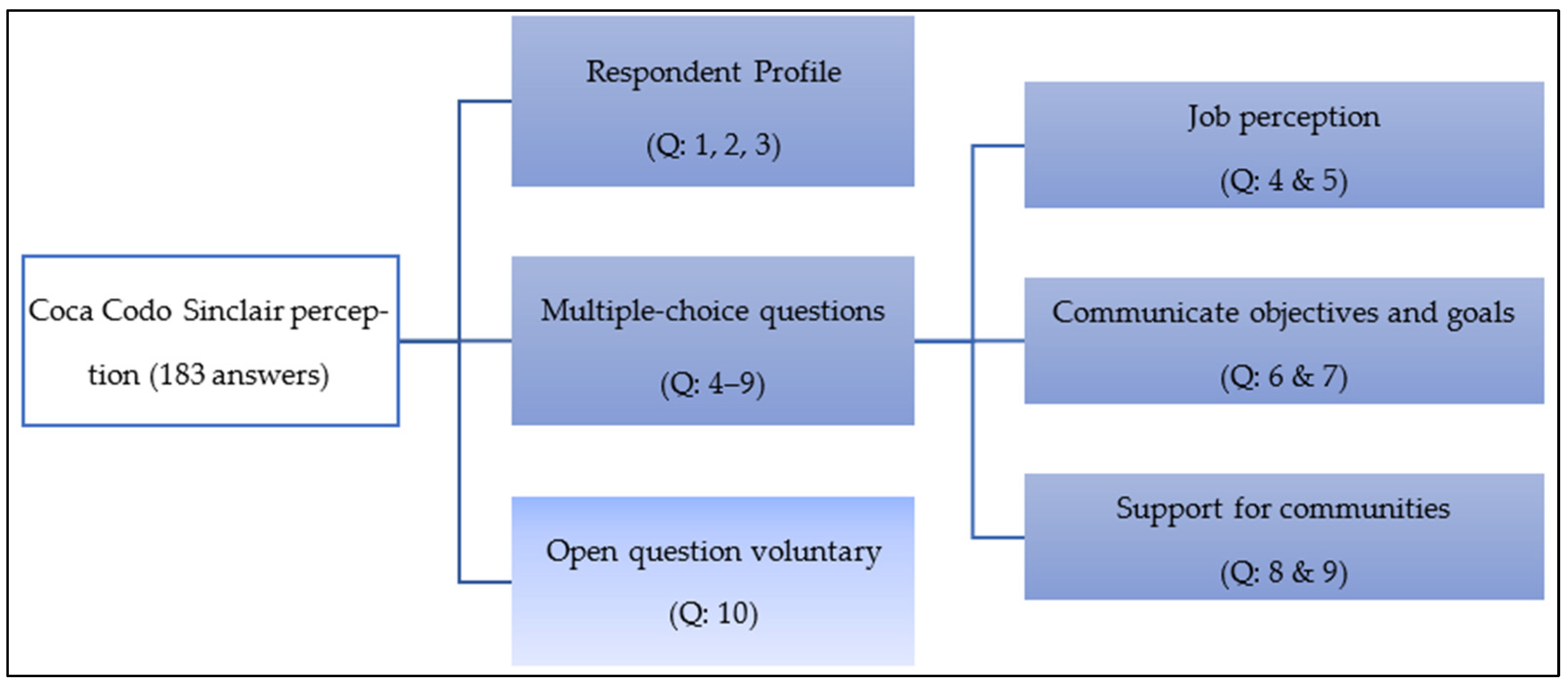Perceptions of Four Rural Communities Regarding the Largest Hydropower Project in Ecuador: The Case of Coca Codo Sinclair
Abstract
1. Introduction
2. Materials and Methods
2.1. Study Area
2.2. Data Analysis and Collection
3. Results
Response to a Voluntary Open Question (Additional Observations)
4. Discussion
5. Conclusions
Author Contributions
Funding
Institutional Review Board Statement
Informed Consent Statement
Data Availability Statement
Acknowledgments
Conflicts of Interest
Appendix A
| No. | Question | Theme |
|---|---|---|
| 1 | Mention your gender and age? | Personal data |
| 2 | What is your occupation? | |
| 3 | How long have you lived in El Chaco, San Carlos, San Luis, or Lumbaqui? | |
| 4 | Is your work or any direct relative’s work related to the Coca Codo Sinclair project? | Job perception and training for the communities |
| 5 | Are there capacity-building programs for the inhabitants of Chaco, San Carlos, San Luis, or Lumbaqui based on the needs identified by the Coca Codo Sinclair operator company? | |
| 6 | Did the company that built the Coca Codo Sinclair hydropower share the objectives and goals of the project via talks, meetings, approaches, etc.? | Objectives and goals communicated to the communities |
| 7 | Is there encouragement and participation from the Coca Codo Sinclair hydropower operator company to gather ideas from people to improve the community’s care? | |
| 8 | Does the hydropower operating company strive and provide environmental or social care resources in El Chaco, San Carlos, San Luis, or Lumbaqui? | Support from the operator company to the communities |
| 9 | Does the company arrange financial aid to the communities’ inhabitants from the Government, Foundations, or Non-Governmental Organisations (NGOs) to address problems or undertakings? | |
| 10 | Please detail any other data, topic, or observation you want to mention or that the hydropower project operator company should consider. (This is extracted from the narration provided by the respondents.) | Additional observations |
References
- Ministry of Energy and Non-Renewable Resources of Ecuador. National Energy Balance of Ecuador; Ministry of Energy and Non-Renewable Resources: Quito, Ecuador, 2024; Available online: https://www.recursosyenergia.gob.ec (accessed on 13 June 2025).
- International Hydropower Association. Hydropower Status Report 2019: Sector Trends and Insights; International Hydropower Association: London, UK, 2019; Available online: https://www.hydropower.org/publications/status2019 (accessed on 30 June 2025).
- International Hydropower Association. Hydropower Status Report 2024: Sector Trends and Insights; International Hydropower Association: London, UK, 2024; Available online: https://www.hydropower.org/publications/2024-world-hydropower-outlook (accessed on 17 July 2025).
- Regional Energy Integration Commission of South America. Energy Publications of South America. Available online: https://cier.org/noticia/ecuador-logra-ampliar-los-recursos-de-generacion-electrica-con-colombia/ (accessed on 22 July 2025).
- British Petroleum, P.L.C. Statistical Review of World Energy 2024: Globally Consistent Data on World Energy Markets; BP P.L.C.: London, UK, 2024; Available online: https://www.bp.com/content/dam/bp/business-sites/en/global/corporate/pdfs/energy-economics/energy-outlook/bp-energy-outlook-2024.pdf (accessed on 16 July 2025).
- Carvajal, P.E.; Li, F.G.N. Challenges for hydropower-based national determined contributions: A case study for Ecuador. Clim. Policy 2019, 19, 974–987. [Google Scholar] [CrossRef]
- Naranjo-Silva, S. A hydropower development perspective in Ecuador: Past, present, and future. La Granja 2024, 39, 63–77. [Google Scholar] [CrossRef]
- Llerena-Montoya, S.; Velastegui-Montoya, A.; Zhirzhan-Azanza, B.; Herrera-Matamoros, V.; Adami, M.; de Lima, A.; Moscoso-Silva, F.; Encalada, L. Multitemporal analysis of land use and land cover within an oil block in the Ecuadorian Amazon. ISPRS Int. J. Geo Inf. 2021, 10, 191. [Google Scholar] [CrossRef]
- Ponce-Jara, M.; Castro, M.; Pelaez-Samaniego, M.; Espinoza-Abad, J.; Ruiz, E. Electricity sector in Ecuador: An overview of the 2007–2017 decade. Energy Policy 2018, 113, 513–522. [Google Scholar] [CrossRef]
- Naranjo-Silva, S.; Romero-Bermeo, J. Coca Codo Sinclair Hydropower Plant: A time bomb in the energy sector for Ecuador or a successful project? Enfoque UTE 2025, 16, 26–37. [Google Scholar] [CrossRef]
- Martínez-Lucas, G.; Fernández-Guillamón, A.; Mier, V.A.G.; Sarasua, J.I. Frequency Regulation Analysis of the Coca Codo Sinclair Hydropower Plant (Ecuador) in Isolated Operation with High Wind Power Penetration. IEEE Access 2025, 13, 148003–148015. [Google Scholar] [CrossRef]
- Sovacool, B.K.; Brossmann, B. The rhetorical fantasy of energy transitions: Implications for energy policy and analysis. Technol. Anal. Strat. Manag. 2014, 26, 837–854. [Google Scholar] [CrossRef]
- The New York Times. It Doesn’t Matter if Ecuador Can Afford This Dam. China Still Gets Paid; The New York Times: New York, NY, USA, 2018; p. 28. [Google Scholar]
- Terneus-Paez, F.; Jiménez-Medoza, S. The water-energy nexus: Analysis of the water flow of the Coca Codo Sinclair Hydroelectric Project. Ingenius 2019, 21, 53–62. [Google Scholar] [CrossRef]
- Terneus, E. Coca Codo Sinclair y la Erosión Regresiva; Universidad Internacional del Ecuador: Quito, Ecuador, 2020; Available online: https://www.uide.edu.ec/coca-codo-sinclair-y-la-erosion-regresiva/ (accessed on 8 June 2024).
- Mekonnen, T.W.; Teferi, S.T.; Kebede, F.S.; Anandarajah, G. Assessment of Impacts of Climate Change on Hydropower-Dominated Power System—The Case of Ethiopia. Appl. Sci. 2022, 12, 1954. [Google Scholar] [CrossRef]
- Godoy, J.C.; Cajo, R.; Estrada, L.M.; Hamacher, T. Multi-criteria analysis for energy planning in Ecuador: Enhancing decision-making through comprehensive evaluation. Renew. Energy 2025, 241, 122278. [Google Scholar] [CrossRef]
- López, I.G.; Araujo, S.; Ruiz, M. Travel-time seismic tomography for the seismic stratigraphic interpretation of the crust around the San Rafael knickpoint at Coca River, Ecuador. Braz. J. Geol. 2024, 54. [Google Scholar] [CrossRef]
- Naranjo-Silva, S.; del Castillo, J.Á. Hydropower: Projections in a changing climate and impacts by this ‘clean’ source. CienciAmérica 2021, 10, 32. [Google Scholar] [CrossRef]
- Naranjo-Silva, S.; Punina, J.; Del Castillo, J.Á. Comparative cost per kilowatt of the latest hydropower projects in Ecuador. InGenio J. 2022, 5, 22–34. [Google Scholar] [CrossRef]
- Dall-Orsoletta, A.; Uriona-Maldonado, M.; Dranka, G.; Ferreira, P. A review of social aspects integration in system dynamics energy systems models. Int. J. Sustain. Energy Plan. Manag. 2022, 36, 33–52. [Google Scholar] [CrossRef]
- Castro-Diaz, L.; Lopez, M.C.; Moore, S.; Radonic, L.; Hodbod, J.; Moran, E. Multidimensional and multitemporal energy injustices: Exploring the downstream impacts of the Belo Monte hydropower dam in the Amazon. Energy Res. Soc. Sci. 2024, 113, 103568. [Google Scholar] [CrossRef]
- Telli, A.; Kırısık, A.; Quaranta, E.; Kuriqi, A.; Kasiulis, E.; Muntean, S. Hydropower’s Role in Enhancing Energy Justice: Preliminary Insights from the EU and Turkey. IOP Conf. Ser. Earth Environ. Sci. 2025, 1442, 012009. [Google Scholar] [CrossRef]
- Dritsas, E.; Trigka, M. Methodological and Technological Advancements in E-Learning. Information 2025, 16, 56. [Google Scholar] [CrossRef]
- Habu, A.A.; Henderson, T. Data subject rights as a research methodology: A systematic literature review. J. Responsible Technol. 2023, 16, 100070. [Google Scholar] [CrossRef]
- Sahu, N.; Sayama, T.; Saini, A.; Panda, A.; Takara, K. Understanding the hydropower and potential climate change impact on the himalayan river regimes—A study of local perceptions and responses from himachal pradesh, india. Water 2020, 12, 2739. [Google Scholar] [CrossRef]
- Open Street Map. Location of Ecuadorian Hydroelectric Plants, Location of Ecuadorian Hydroelectric Plants. Available online: https://www.openstreetmap.org/note/2721104#map=6/-0.754/-73.334 (accessed on 3 August 2025).
- Vaca-Jiménez, S.; Gerbens-Leenes, P.W.; Nonhebel, S. The water footprint of electricity in Ecuador: Technology and fuel variation indicate pathways towards water-efficient electricity mixes. Water Resour. Ind. 2019, 22, 100112. [Google Scholar] [CrossRef]
- Sivongxay, A.; Greiner, R.; Garnett, S.T. Livelihood impacts of hydropower projects on downstream communities in central Laos and mitigation measures. Water Resour. Rural. Dev. 2017, 9, 46–55. [Google Scholar] [CrossRef]
- Instituto Nacional de Estadística y Censos (INEC). Sucumbíos Provincial Fascicle: Population Structure; INEC: Quito, Ecuador, 2020; Available online: https://www.ecuadorencifras.gob.ec/wp-content/descargas/Manu-lateral/Resultados-provinciales/sucumbios.pdf (accessed on 3 July 2025).
- Instituto Nacional de Estadística y Censos (INEC). Napo Provincial Fascicle: Population Structure; INEC: Quito, Ecuador, 2020; Available online: http://www.ecuadorencifras.gob.ec/wp-content/descargas/Manu-lateral/Resultados-provinciales/napo.pdf (accessed on 13 September 2025).
- GAD El Chaco. Population Figures of the Decentralized Autonomous Government. Available online: https://gadmunicipalelchaco.gob.ec/ (accessed on 12 April 2021).
- GAD Gonzalo Pizarro. Population figures of the Decentralized Autonomous Government. Available online: https://gonzalopizarro.gob.ec (accessed on 12 April 2021).
- Badii, M.H.; Castillo, J.; Guillen, A. Optimum Sample Size. Innovaciones Neg. 2008, 5, 53–65. Available online: https://revistainnovaciones.uanl.mx/index.php/revin/article/view/199 (accessed on 1 April 2025).
- Souksavath, B.; Maekawa, M. The livelihood reconstruction of resettlers from the Nam Ngum 1 hydropower project in Laos. Int. J. Water Resour. Dev. 2013, 29, 59–70. [Google Scholar] [CrossRef]
- Winton, R.S.; Teodoru, C.R.; Calamita, E.; Kleinschroth, F.; Banda, K.; Nyambe, I.; Wehrli, B. Anthropogenic influences on Zambian water quality: Hydropower and land-use change. Environ. Sci. Process Impacts 2021, 23, 981–994. [Google Scholar] [CrossRef] [PubMed]
- Cárdenas, M.; Filonzi, A.; Delgadillo, R. Finite element and experimental validation of sample size correction factors for indentation on asphalt bitumens with cylindrical geometry. Constr. Build. Mater. 2021, 274. [Google Scholar] [CrossRef]
- Gordillo, F.; Elsasser, P.; Günter, S. Willingness to pay for forest conservation in Ecuador: Results from a nationwide contingent valuation survey in a combined ‘referendum’—‘Consequential open-ended’ design. For. Policy Econ. 2019, 105, 28–39. [Google Scholar] [CrossRef]
- Pfister, S.; Scherer, L.; Buxmann, K. Water scarcity footprint of hydropower based on a seasonal approach—Global assessment with sensitivities of model assumptions tested on specific cases. Sci. Total Environ. 2020, 724, 138188. [Google Scholar] [CrossRef]
- Cevallos, B.; Urquizo, J. Spatial national multi-period long-term energy and carbon planning scenarios in Ecuador’s electric system. J. Environ. Manag. 2024, 370, 122010. [Google Scholar] [CrossRef]
- Purcell, T.F.; Martinez, E. Post-neoliberal energy modernity and the political economy of the landlord state in Ecuador. Energy Res. Soc. Sci. 2018, 41, 12–21. [Google Scholar] [CrossRef]
- CELEC. CELEC EP Genera y transmite más del 90 por Ciento de la Energía Eléctrica Limpia que consume el País y exporta a los Países Vecinos. Available online: https://www.celec.gob.ec/noticias/celec-ep-genera-y-transmite-mas-del-90-por-ciento-de-la-energia-electrica-limpia-que-consume-el-pais-y-exporta-a-los-paises-vecinos/ (accessed on 22 May 2021).
- Riascos, F.; Cepeda, J. Modelación Matemática de los Sistemas de Control de Velocidad de Unidades de la Central Hidroeléctrica Coca Codo Sinclair. Rev. Técnica Energía 2021, 18, 59–71. [Google Scholar] [CrossRef]
- Lala, J.O.; Mora, H.C.; Garzón, N.O.; Vega, J.; Ohishi, T. Examining the Evolution of Energy Storing in the Ecuadorian Electricity System: A Case Study (2006–2023). Energies 2024, 17, 3500. [Google Scholar] [CrossRef]
- Teräväinen, T. Negotiating water and technology-Competing expectations and confronting knowledges in the case of the Coca Codo Sinclair in Ecuador. Water 2019, 11, 411. [Google Scholar] [CrossRef]
- Souksavath, B.; Nakayama, M. Reconstruction of the livelihood of resettlers from the Nam Theun 2 hydropower project in Laos. Int. J. Water Resour. Dev. 2013, 29, 71–86. [Google Scholar] [CrossRef]
- Negi, G.C.S.; Punetha, D. People’s perception on impacts of hydropower projects in Bhagirathi River valley, India. Environ. Monit. Assess. 2017, 189, 138. [Google Scholar] [CrossRef] [PubMed]
- Okuku, E.O.; Bouillon, S.; Ochiewo, J.O.; Munyi, F.; Kiteresi, L.I.; Tole, M. The impacts of hydropower development on rural livelihood sustenance. Int. J. Water Resour. Dev. 2016, 32, 267–285. [Google Scholar] [CrossRef]
- Onsongo, E.; Eludoyin, E.O.; Tesfamichael, M.; Tomei, J. The political economy of least cost power planning in Kenya. Energy Policy 2025, 207, 114819. [Google Scholar] [CrossRef]
- Mayer, A.; Castro-Diaz, L.; Lopez, M.C.; Leturcq, G.; Moran, E.F. Is hydropower worth it? Exploring amazonian resettlement, human development and environmental costs with the Belo Monte project in Brazil. Energy Res. Soc. Sci. 2021, 78, 102129. [Google Scholar] [CrossRef]
- De Queiroz, A.R.; Faria, V.A.D.; Lima, L.M.M.; Lima, J.W.M. Hydropower revenues under the threat of climate change in Brazil. Renew. Energy 2019, 133, 873–882. [Google Scholar] [CrossRef]
- Raimundo, D.R.; Cavaliero, C.K.N.; da Cunha, M.P. Contribution of floating photovoltaic systems in hydropower plants for the expansion of Brazilian electricity sector. Renew. Energy 2025, 254, 123754. [Google Scholar] [CrossRef]
- Haddad, Y.Y.; Gudmundsson, L.; Savelsberg, J.; Garrison, J.B.; Raycheva, E.; Wechsler, T.; Zappa, M.; Hug, G.; I Seneviratne, S. Recent climate impacts on run-of-river hydropower and electricity systems planning in Switzerland. Environ. Res. Lett. 2025, 20, 084020. [Google Scholar] [CrossRef]
- Addai, G.O.; Ofosu, E.A.; Domfeh, M.K.; Wusah, R.B.; Agyemang-Boakye, B.; Yankey, B.E. Potential for small hydropower development in the Tano River Basin of Ghana using SWAT and RETScreen. Energy Sustain. Dev. 2025, 86, 101720. [Google Scholar] [CrossRef]
- Hunt, J.D.; Nascimento, A.; Zakeri, B.; Ilyas, A.; Ramos, D.S.; Kuriqi, A.; Tolmasquim, M.T.; de Freitas, M.A.V.; Brandão, R.; Wada, Y. Optimizing hydropower generation with reservoir level management in humid regions. Energy Rep. 2025, 13, 856–864. [Google Scholar] [CrossRef]
- Tobes, I.; Conrad, E.; Rivera-Albuja, J.; Ríos-Touma, B.; Miranda, R. Fish Ecology and Hydrological Responses to a Run-of-River Hydroelectric Project in Ecuador. Fishes 2025, 10, 143. [Google Scholar] [CrossRef]
- Velastegui-Montoya, A.; García-Romero, J.A.; Chuizaca-Espinoza, I.A.; Quevedo, R.P.; Santana-Cunha, C.; Ochoa-Brito, J.I.; Arias-Hidalgo, M. Assessing regressive erosion effects: Unveiling riverside land use land cover changes post hydroelectric project construction. Environ. Chall. 2024, 15, 100882. [Google Scholar] [CrossRef]
- Sovacool, B.K.; Walter, G. Internationalizing the political economy of hydroelectricity: Security, development and sustainability in hydropower states. Rev. Int. Polit. Econ. 2019, 26, 49–79. [Google Scholar] [CrossRef]
- Agyeman, J. Sustainable Communities and the Challenge of Environmental Justice; New York University Press: New York, NY, USA; London, UK, 2015; Available online: https://dokumen.pub/sustainable-communities-and-the-challenge-of-environmental-justice-9780814707746.html (accessed on 29 July 2025).
- Xu, J.; Lv, T.; Hou, X.; Deng, X.; Meng, X.; Li, N.; Liu, F. Assessing the provincial renewable energy generation efficiency in China considering the energy justice and sustainable development. Sustain. Energy Technol. Assess. 2024, 72, 104086. [Google Scholar] [CrossRef]
- Del Puerto, M.C.L. Exploring the Energy Security and Justice Implications of Large Transboundary Hydropower Dams. Ph.D. Thesis, University of Sussex, Brighton, UK, 2023. Available online: https://sussex.figshare.com/articles/thesis/Exploring_the_energy_security_and_justice_implications_of_large_transboundary_hydropower_dams/25040186 (accessed on 8 October 2025).
- Mayeda, A.M.; Boyd, A.D. Factors influencing public perceptions of hydropower projects: A systematic literature review. Renew. Sustain. Energy Rev. 2020, 121, 109713. [Google Scholar] [CrossRef]
- Hensengerth, O. South-South technology transfer: Who benefits? A case study of the Chinese-built Bui dam in Ghana. Energy Policy 2018, 114, 499–507. [Google Scholar] [CrossRef]
- Naranjo-Silva, S.; del Castillo, J.Á. An Approach of the Hydropower: Advantages and Impacts. A Review. J. Energy Res. Rev. 2021, 8, 10–20. [Google Scholar] [CrossRef]
- Liu, B.; Lund, J.R.; Liu, L.; Liao, S.; Li, G.; Cheng, C. Climate change impacts on hydropower in Yunnan, China. Water 2020, 12, 197. [Google Scholar] [CrossRef]
- Samjhana, R.S.; Manan, S. Projected Hydropower Capacity under Changing Climate Conditions and Its Implications in South and Southeast Asia. Am. J. Clim. Change 2025, 14, 230–247. [Google Scholar] [CrossRef]





| No. | Community Surveyed | Location | State | Households |
|---|---|---|---|---|
| 1 | El Chaco a | Upstream | Napo | 1107 |
| 2 | San Carlos a | Upstream | Napo | 387 |
| 3 | Lumbaqui b | Downstream | Sucumbios | 1189 |
| 4 | San Luis b | Downstream | Sucumbios | 425 |
| Total population (TP) in households c | 3108 | |||
| Population near the principal roads (70%) c | 2176 | |||
Disclaimer/Publisher’s Note: The statements, opinions and data contained in all publications are solely those of the individual author(s) and contributor(s) and not of MDPI and/or the editor(s). MDPI and/or the editor(s) disclaim responsibility for any injury to people or property resulting from any ideas, methods, instructions or products referred to in the content. |
© 2025 by the authors. Licensee MDPI, Basel, Switzerland. This article is an open access article distributed under the terms and conditions of the Creative Commons Attribution (CC BY) license (https://creativecommons.org/licenses/by/4.0/).
Share and Cite
Naranjo-Silva, S.; Punina-Guerrero, D.J.; Jacome-Dominguez, E.A. Perceptions of Four Rural Communities Regarding the Largest Hydropower Project in Ecuador: The Case of Coca Codo Sinclair. Limnol. Rev. 2025, 25, 52. https://doi.org/10.3390/limnolrev25040052
Naranjo-Silva S, Punina-Guerrero DJ, Jacome-Dominguez EA. Perceptions of Four Rural Communities Regarding the Largest Hydropower Project in Ecuador: The Case of Coca Codo Sinclair. Limnological Review. 2025; 25(4):52. https://doi.org/10.3390/limnolrev25040052
Chicago/Turabian StyleNaranjo-Silva, Sebastian, Diego Javier Punina-Guerrero, and Edwin Angel Jacome-Dominguez. 2025. "Perceptions of Four Rural Communities Regarding the Largest Hydropower Project in Ecuador: The Case of Coca Codo Sinclair" Limnological Review 25, no. 4: 52. https://doi.org/10.3390/limnolrev25040052
APA StyleNaranjo-Silva, S., Punina-Guerrero, D. J., & Jacome-Dominguez, E. A. (2025). Perceptions of Four Rural Communities Regarding the Largest Hydropower Project in Ecuador: The Case of Coca Codo Sinclair. Limnological Review, 25(4), 52. https://doi.org/10.3390/limnolrev25040052








